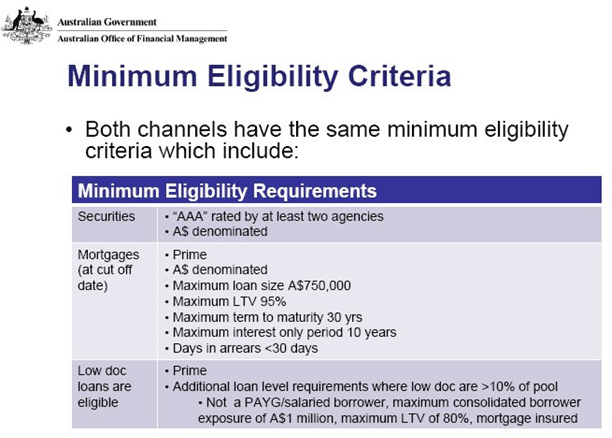
In recent weeks the dynamic duo of Mark Bouris and Christopher Joye of Yellow Brick Road have argued hither and thither for a dramatic shift in the rules that govern the Australian financial system. They have recently appeared in the ABC, AFR and The Australian (as well as no doubt being the secret “bankers” referred to yesterday by Robert Gottliebsen at BS) to propose that the Australian Budget should be deployed as a guarantor for pools of mortgages aggregated from all banks and non-bank lenders. They propose this as a solution to the competition woes afflicting the current system, which guarantees individual banks, privileging the large over the small.
Here is a sample from their recent AFR article:
The real trouble with this banking system is that it’s based on a flawed paradigm: a purported conflict between stability and competition, which the big banks highlight when justifying their margin expansion.
Yet these two objectives are, in fact, complementary. The financial system would be safer if we had 10 smaller banks worth $25 billion each, so that none is individually big enough to threaten the system’s viability compared with the four too-big-to-fail behemoths, worth about $250 billion combined, that we have today.
In a similar vein, Bendigo and Adelaide Bank chairman Robert Johanson argues, “We went into the crisis with no bank too big to fail . . . Coming out of it, I don’t think that’s the case . . . We’ve ended up with an industry structure that’s far more rigid, and . . . more vulnerable to the next shock.”
Policymakers should accept that government guarantees of banks are a prerequisite for safe “maturity transformation”. But this taxpayer insurance must be properly priced, or you encourage a US-style situation whereby a handful of implicitly government-backed lenders dominate financial intermediation to the detriment of competition and stability.
When extending liquidity and insurance to banks, Treasury or the RBA should not rely on ratings agencies. The Australian Prudential Regulation Authority monitors and controls every bank’s risk, and the cost of taxpayer support should be APRA’s intrusive regulation, and thus priced the same for all institutions.
In preference to guaranteeing nebulous “institutions”, taxpayers should focus on insuring safer assets. If the government offered a credit-wrap of mortgage loss insurance like the Canadians do, it would formally price an implicit guarantee that already exists (generating substantial revenue) while levelling the playing field.
This would allow all banks to raise capital on similar terms and help eliminate the too-big-to-fail advantages that the majors now have. The Australian Securities and Investments Commission chairman, Greg Medcraft, also supports this.
Finally, why not require all banks to publish a regular index of their funding costs and net interest margins to end the asinine monthly RBA rate debate. We’re surprised the majors haven’t offered to do so.
Bouris and Joye have done a great job of describing the distortions of the current system. We at MB agree and recommend you read their articles. What makes us nervous, however, is their proposal to use the Government’s balance sheet to purchase pooled mortgages and resell them to investors as AAA-rated government-backed bonds, thus providing banks and other mortgage lenders with an immediate source of cash that they can re-lend.
As they mention, the approach championed by Bouris and Joye is effectively the system currently in place in Canada via the government-owned Canadian Mortgage Housing Corporation (CMHC), as well as the process employed by Fannie Mae and Freddie Mac, which exposed US taxpayers to huge losses when the US housing bubble burst.
While the proposal is interesting, there are a number of issues that would need to be resolved prior to moving in such a direction. These issues include:
- First, how will moral hazards be managed under such a proposal, in order to reduce the incentives for banks to reduce underwriting standards in order to sell as many mortgages as possible, in the knowledge that any default risks will ultimately be borne by the taxpayer? The Fannie Mae and Freddie Mac debacle in the US highlighted what can go wrong when lender’s incentives do not align with taxpayers, so moral hazards need to be managed carefully.
- Second, what controls will be in place to ensure that only the highest quality borrowers receive credit under such a system, in order to ensure that taxpayers are not exposed to low quality mortgages and default risk? Fannie Mae, Freddie Mac and the CMHC have all been embued with ‘affordability mandates’ that requires them to supply credit-enhancement and securitisation services to facilitate the provision of finance to low-income and/or disadvantaged households where there is private-market failure to do so. Some would argue that such mandates exacerbated sub-prime lending in the US, resulting in greater losses to taxpayers.
- Finally, what sorts of loan-to-value (LTV) restrictions will be in place? Current AOFM requirements on the Government’s budgeted $20b of RMBS purchases are not exactly “conservative”, permitting 95% LTV, $750,000 loan sizes, 10-year interest only loans, and some low doc loans (see below slide).

In fact, the Bouris/Joye proposal really begs the question what is the point of having private banks at all? If credit quality is simply to be enhanced by a government wrap then why bother with credit assessment? If liabilities are to be guaranteed then why bother with balance sheet management? If assets are to be protected by fiscal largesse then why bother with collateral quality? We at MB may start our own AAA mortgage shop to cash in on the rent seeking. The irony is made all the more palpable when you consider that what is being proposed as a solution to too-big-to-fail is, in fact, that everybody fail equally, and fall together into the lap of tax-payer support.
There is also the law of unintended consequences of which there will be many. Just one is that if you set up a system to provide a government guarantee on only some new mortgages, all other mortgages will be seen to be relatively risky and the cost of funding these must increase over time to very high levels relative to government guaranteed mortgages. This is an analogous problem to that created by covered bonds, where the guarantees of collateral provided to some investors upset the remaining unsecured investors, driving up the price of funding anyway. The Joye/Bouris proposal would risk creating either different borrower classes or forcing those who can to refinance into a government guaranteed mortgage and/or making no difference to bank funding costs anyway.
No, what Australia must do first is return to first principal questions about what kind of banking system we want and need. What kind of financial system is in the national interest? Do we really want another round of mortgage oriented credit creation further displacing business banking skills and issuance? What reforms are needed to deliver the system we want? And what trade offs are appropriate in constructing it?
The previous Inquiry (the ‘Wallis’ Inquiry), completed in 1997, never envisaged systemic risk engulfing financial markets as well as intermediaries, as occurred during the GFC. And it explicitly ruled-out ever guaranteeing any part of the financial system. The patchwork of adjustments that have been made to the architecture since the GFC have rendered it unrecognisable. This process of policy on the run must stop.
If there was ever a time for strong political leadership on banking policy, it is now.